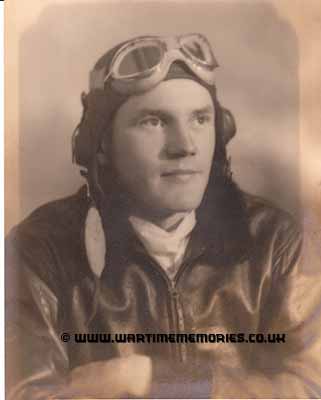|
|
|
209487 Rmcs. Douglas S. "Pete" Peterson DFC.Uniteds States Navy Squadron VB-110 from:Aitkin, MN  My father, Doug Peterson, served in VB-110 from June 1943 to June 1944, with his last mission (25th) flown on D-Day over the beaches of Normandy. He was the Radioman/Navigator on a PB4Y-1 Liberator bomber, in the squadron that Joseph P. Kennedy Jr. served in. Although he wasn't in Kennedy's crew, he flew several checkout flights with him to train new Radio/Navigators. Of all the stories he told me over the years, the one that intrigues me most concerns a patrol he flew in which his crew shot down a German ME109 using a depth charge.
Their normal mission profile consisted of flying 50ft above the water searching for German subs on the surface of the water using the radar installed where the ball turret was usually located. Their patrol area was in the Bay of Biscay, and on this particular patrol, they were not very long into the mission when my father picked up two blips on the radar approaching them from the coast, at a high speed. He informed the skipper that two "bogeys" were pursuing them, and they would soon be under attack.
Knowing that they were all alone, and no match for two fighters, the pilot quickly devised a plan to try to take the fighters by surprise. He knew that intercept attacks usually consisted of two fighters flown by one experienced pilot, and one less experienced (for training purposes I suppose). The experienced fighter pilot would lead, with the rookie trailing to watch his technique. The bomber pilot also knew that if he could get the fighter to come down low to make his attack, and if he timed it right, he could get the fighter with the huge geyser produced by an exploding depth charge. So, he headed out to sea to draw the lower ranged fighters away from their base, and ordered a depth charge set for zero depth, and told the tail gunner to tell him precisely when he could see the fighter open up with his guns. He reasoned that the range of the fighters guns, calculated with their airspeed, and the time it would take for the depth charge to go off, would be just right to catch the fighter in a geyser. Very soon the tail gunner shouted out that he could see the fighters, and that they were two ME109's closing fast on their tail. A moment later, he shouted that the first fighter was firing his guns, and the skipper dropped the depth charge. As the depth charge hit the water, and they passed by, it exploded, sending a hundred foot wall of water up in front of the pursuing fighter. The German pilot never knew what hit him. His wings were torn off and he crashed into the sea. The rookie pilot trailing him lost his nerve and turned for home.
If there is anyone out there that has any more information about this, I would love to hear from you. I've searched all over the internet looking for any record of this incident, but haven't had any luck.
|
Can you help us to add to our records?
The names and stories on this website have been submitted by their relatives and friends. If your relations are not listed please add their names so that others can read about them
Did you or your relatives live through the Second World War? Do you have any photos, newspaper clippings, postcards or letters from that period? Have you researched the names on your local or war memorial?
Were you or your relative evacuated? Did an air raid affect your area?
If so please let us know.
Help us to build a database of information on those who served both at home and abroad so that future generations may learn of their sacrifice.
Celebrate your own Family History
Celebrate by honouring members of your family who served in the Secomd World War both in the forces and at home. We love to hear about the soldiers, but also remember the many who served in support roles, nurses, doctors, land army, muntions workers etc.
Please use our Family History resources to find out more about your relatives. Then please send in a short article, with a photo if possible, so that they can be remembered on these pages.
|
|




